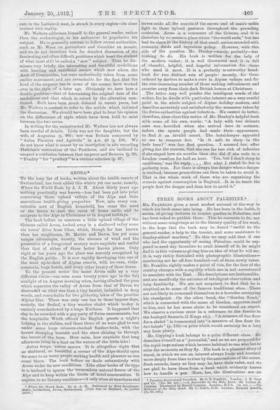THREE BOOKS ABOUT PALESTINE.*
MR. FRANKLIN gives a most modest account of the way in which his book came into being. Ho has been in the- habit, it seems, of giving lectures to tourist .parties in Palestine, and has been asked to publish them. This he consents to do, not without some misgivings as to the literary quality of his work,. in the hope that the book may be found "useful to the general reader, a help to the tourist, and some • assistance to Sunday-school teachers." To this we may add that if one who had the opportunity of seeing Palestine -could be sup- posed to need any incentive to avail himself of it, he might find it in this volume as giving-him an idea of what he will see. It is very richly furnished with photographic illustrations, numbering not far off four hundred—all althorn newly taken. Mr. Franklin rightly makes a point of this, for the face of the country changes with a rapidity which one is not accustomed to associate with the East. His descriptions: are businesslike, and are manifestly the outcome of intelligent observation and lung familiarity. We are not surprised- to find that he is sceptical as to some of the famous traditional sites,. These are not likely to commend themselves to a traveller occupying his standpoint. On the other hand, the " Garden Tomb," which is connected with the name of Gordon, approves itself to him, and he has some claim to be considered an expert. We observe a curious error in a reference to the famine in the besieged Samaria (2 Kings vii.). "A measure .of fine flour for a shekel" is transmuted into "a measure of fine flour for two talents" (p. 159)—a price which would certainly be :a long way from plenty.
Mr. Copping's book belongs to a quite different class. He describes himself as a " journalist," and so we are prepared for the rapid impressions which become habitual to ono who has to seize the moments as they fly. His book is a pleasant story of travel, in which we see an interest always lively and touched more deeply from time to time by the associations .of the scene. Such records, hasty as they may be, have their value, and we are glad to have them from a hand which eVidently knows how to handle a pen. Here, too, the illustrations are an
• Palestine Depicted and Described. By G. E:Prahltlin; London: J. 5S. Dent and Co. [ies. Od, not.]—A Journalist tin .the Rely Land. By Arthur :E. Copping. Illustrated, by Harold Copping. London: .R.T.S. t5s. net.]—The Romance of the Holy Land. By C. Leach, D.D. Landon: htlward Arnold.
[78. 64.1. net.] important part of the book. We may even guess that but for them it would not have been written. Mr. Harold Copping shows himself at his best, . We prefer his landscapes to his figures, his interpretation of nature to his renderings of action, and it is with nature that he has chiefly to deal here. (We must not forget, however, to praise the fine head which serves as a frontispiece and the "Arab Boy.")
Dr. Leach's book reads as if it were a reproduction of lectures in which he has recorded experiences of travel— he has paid nine visits, we are told, to the Holy Land —and possibly of discourses delivered in old days before he exchanged the pastorate for the duties of an M.P. But whatever its origin it will be found worth reading. A genuine interest in all that the Holy Land stands for, strengthened and developed by actual observation of scenes and places, is bound to produce a result of some value. We must own that some of Dr. Leach's renderings of Scripture narratives seem to us a little commonplace. On the other hand we often come upon touches which really interest. We observe that Dr. Leach has no difficulty in accepting the traditional site of the Holy Sepulchre. " The site of the Church of the Holy Sepulchre was outside the walls of the city in the days of the Crucifixion, and was enclosed some years afterwards when one of the 'Herods took into the city a large portion • of land on the northern side." This, we are told, is a "fact." If it is so really, it settles everything, and we should like to have the authority. The attribution of the hymn " Christian, dolt thou see them P," to St. Andrew of Crete (p.159) is, we may remark, without founda- tion. It must be said, however, that John Mason Neale was responsible for the idea. He published it among his "Hymns of the Eastern Church," giving St. Andrew as the author and prefixing a Greek line which might be taken as the first line of the original (o6 yap filAirecs role rapdvrorras), but the original has never been seen.











































 Previous page
Previous page